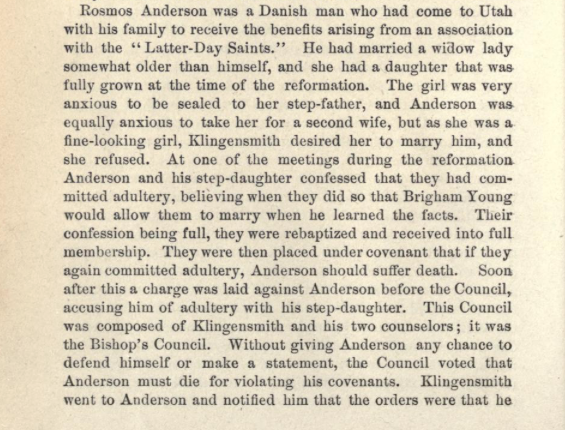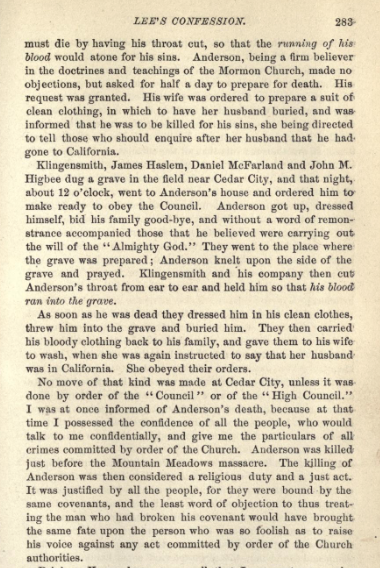JDL alleges that RA was killed to atone for adultery so the bishop could marry his wife.
- Type
- Book
- Hearsay
- 2nd Hand
- Reference
John D. Lee, Mormonism Unveiled: The Life and Confession of John D. Lee, Including the Life of Brigham Young (St. Louis: Bryan, Brand & Co., 1877), 282-283
- Scribe/Publisher
- Bryan, Brand & Company
- People
- Brigham Young, Philip Klingensmith, John M. Higbee, James Holt Haslam, Rosmos Anderson, Daniel McFarland, John Doyle Lee
- Audience
- General Public
- Transcription
Rosmos Anderson was a Danish man who had come to Utah with his family to receive the benefits arising from an association with the "Latter-Day Saints." He had married a widow lady somewhat older than himself, and she had a daughter that was fully grown at the time of the reformation. The girl was very anxious to be sealed to her step-father, and Anderson was- equally anxious to take her for a second wife, but as she was a fine-looking girl, Klingensmith desired her to marry him, and she refused. At one of the meetings during the reformation Anderson and his step-daughter confessed that they had committed adultery, believing when they did so that Brigham Young would allow them to marry when he learned the facts. Their confession being full, they were rebaptized and received into full membership. They were then placed under covenant that if they again committed adultery, Anderson should suffer death. Soon after this a charge was laid against Anderson before the Council, accusing him of adultery with his step-daughter. This Council was composed of Klingensmith and his two counselors ; it was the Bishop's Council. Without giving Anderson any chance to defend himself or make a statement, the Council voted that Anderson must die for violating his covenants. Klingensmith went to Anderson and notified him that the orders were that he must die by having his throat cut, so that the running of his blood would atone for his sins. Anderson, being a firm believer in the doctrines and teachings of the Mormon Church, made no objections, but asked for half a day to prepare for death. His request was granted. His wife was ordered to prepare a suit of clean clothing, in which to have her husband buried, and was informed that he was to be killed for his sins, she being directed to tell those who should enquire after her husband that he had gone to California.
Klingensmith, James Haslem, Daniel McFarland and John M. Higbee dug a grave in the field near Cedar City, and that night, about 12 o'clock, went to Anderson's house and ordered him to make ready to obey the Council. Anderson got up, dressed himself, bid his family good-bye, and without a word of remonstrance accompanied those that he believed were carrying out the will of the "Almighty God." They went to the place where the grave was prepared ; Anderson knelt upon the side of the grave and prayed. Klingensmith and his company then cut Anderson's throat from ear to ear and held him so that his blood ran into the grave.
As soon as he was dead they dressed him in his clean clothes, threw him into the grave and buried him. They then carried his bloody clothing back to his family, and gave them to his wife to wash, when she was again instructed to say that her husband was in California. She obeyed their orders.
No move of that kind was made at Cedar City, unless it was done by order of the "Council" or of the "High Council." I was at once informed of Anderson's death, because at that time I possessed the confidence of all the people, who would talk to me confidentially, and give me the particulars of all crimes committed by order of the Church. Anderson was killed just before the Mountain Meadows massacre. The killing of Anderson was then considered a religious duty and a just act. It was justified by all the people, for they were bound by the same covenants, and the least word of objection to thus treating the man who had broken his covenant would have brought the same fate upon the person who was so foolish as to raise his voice against any act committed by order of the Church authorities.
- Citations in Mormonr Qnas
The B. H. Roberts Foundation is not owned by, operated by, or affiliated with the Church of Jesus Christ of Latter-day Saints.


